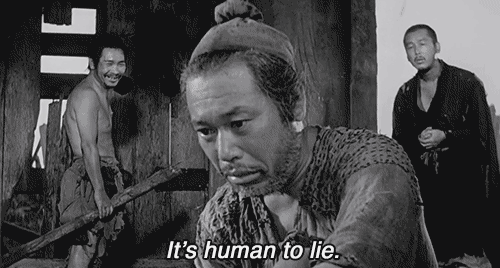 In Akira Kurosawa's timeless
In Akira Kurosawa's timeless
1950 masterpiece (http://www.imdb.com/title/tt0042876/),
a murder and a rape appear to have occurred in the deep woods of 12th-century
Japan. A priest, a woodcutter and a man the script calls “the commoner” are
taking shelter from a rainstorm in the ruined shell of a gatehouse.
The priest
and the woodcutter are recounting to the commoner their testimony at the
investigation of the crime. The other witnesses before the magistrate were the bandit
Tajômaru (the main suspect, played over the top by a young Toshiro Mifune); the
wife of the stabbed samurai; and the dead man himself, who testifies via a spirit
medium. Each witness tells a different story. The forest photography emphasizes
the dappling of sunlight as it filters through leafy trees, neither completely
clear nor completely dark, symbolizing ambiguity.
We see the testimonies via
flashbacks. We are thereby certain of what each witness told the magistrate,
but we have little idea what the truth is, or what the witnesses’ individual
agendas might be.
 Back (or rather, forward) at
Back (or rather, forward) at
the Rashômon gate, the woodcutter tells the commoner and the priest (the priest
only having met the samurai and his wife on the road outside the wood, without
witnessing the actual crime) still another contradictory version of the event.
The commoner is able to see through the woodcutter’s story and penetrate to
some of the truth. The film ends with an event redeeming the woodcutter’s
character, affirming the priest’s fervently desired faith in humanity, and the dying
rainstorm giving way to sunshine.
My thesis students are
discussing the qualitative research module, specifically interview-based
management research. I show the film and ask the students: What if you are
interviewing employees of a company for your thesis, and you get conflicting
stories like this?
In each class there are
math-shy students who are initially drawn to qualitative research because they
think it’s easier than quantitative. It is at this moment that some of them
begin to mumble, “Oh, shit…”
The first question to address
is, why will a researcher be told conflicting stories, and even lies? The
answer is that people suffer from perceptual bias (each employee may sincerely
perceive and interpret an event in a different way), and that everybody is
hiding something, wanting something, or protecting something.
People want the usual things:
Money, power, sex, to love and be loved. Then too, as one Rashomon character wryly notes, “We all
want to forget something, so we tell stories. It's easier that way.” The priest
at the Rashomon gate wants to believe humans are good.
People hide their misdeeds,
real and imagined, past, present, and planned. We also hide the ethical lapses
and illegalities committed by people who are important to us.
People protect their
families, their health, their self-image, their reputation, and their beliefs.
We utter the most outrageous inconsistencies if they leave our core beliefs
unchallenged. Tajomaru, probably falsely, confessed to murdering the samurai,
in order to maintain his aura as the fearsome bandit.
 The qualitative researcher
The qualitative researcher
wants evidence of the truth or falsity of a set of propositions. To the
interviewed employees, truth may be far less important than, say, keeping
harmony in the organization, or pushing product out the door.
What should the researcher
do? As the characters’ retrospective at the Rashomon gate suggests, the researcher
should re-interview the respondents after a certain interval of time, and in a
different setting. Don’t (necessarily) challenge the respondent to contradict
his/her earlier statements. Instead, without naming the other respondents,
choose statements made by them, and ask, “Isn’t it possible that…?”
Bring in a new analyst (“the
commoner”) who wasn’t subject to the respondents’ initial charisma or body
language, and have the new analyst “read between the lines” of the transcribed
interviews. The new analyst might witness the re-interviews.
You might reassure a
respondent that s/he is not the only person who has things to hide and protect.
Coincidentally,
a week after my most recent classroom screening, “Actor Toshirō
Mifune (1920-1997) will be honoured with a star bearing his name on the
Hollywood Walk of Fame.”
http://akirakurosawa.info/2015/06/25/toshiro-mifune-to-a-get-star-on-ho…


